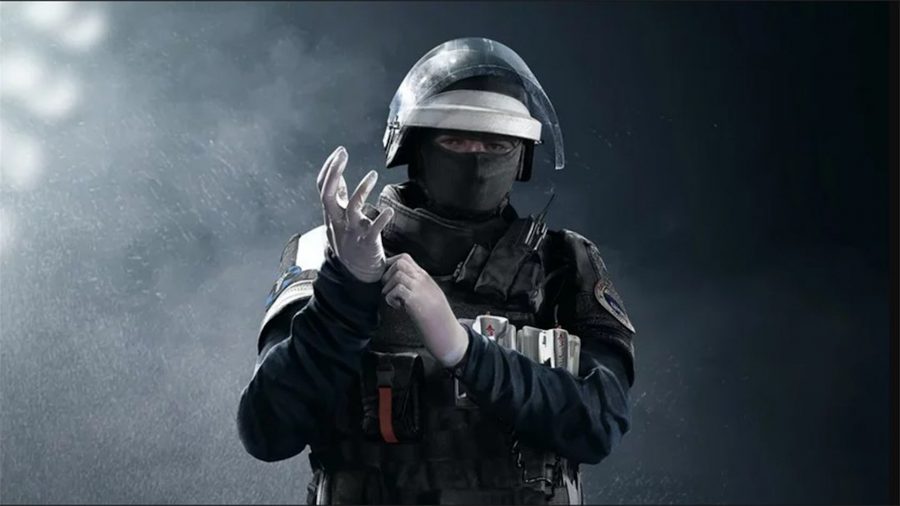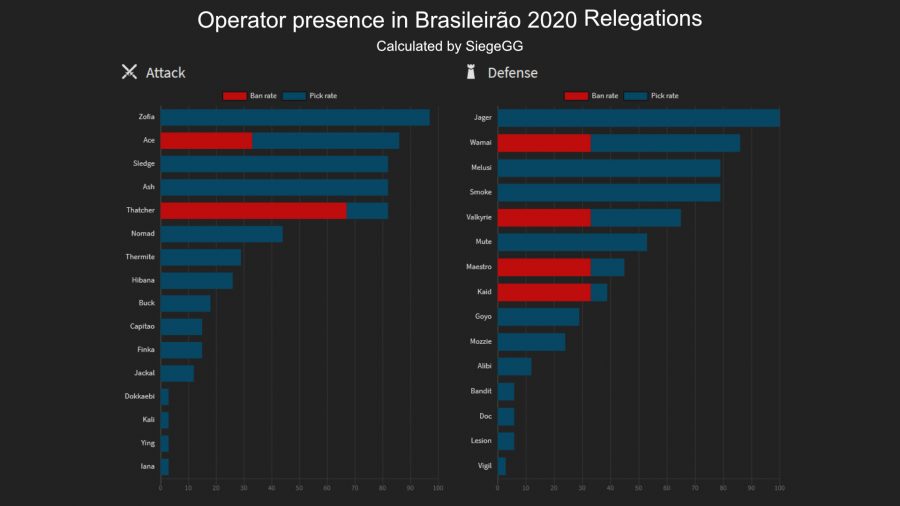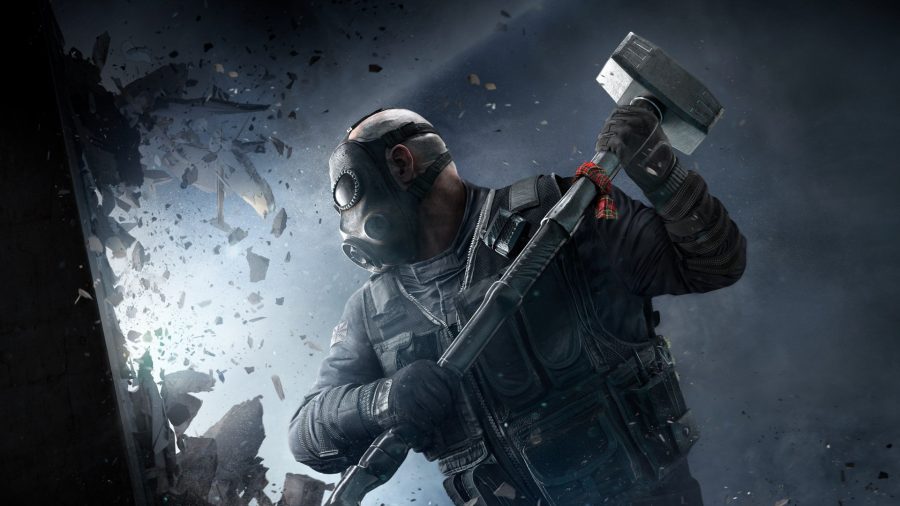Rainbow Six Siege stands apart from other games in the Tom Clancy series with a clear competitive focus and distinct lack of narrative, but over the past few years Ubisoft has taken a page out of the League of Legends handbook in its bid to expand the stories of its vibrant cast of characters. When lore begins to influence the outcome of a professional match where prize money is on the line, however, it’s being used in the wrong way.
During EU League 2020 Relegations, MnM Gaming’s Josh ‘Yuzus’ Pritchard managed to come in clutch against Rogue in a 1v2 situation that would’ve been impossible had he not been playing Zofia. Her unique ‘Withstand’ ability allowed her to pick herself up from a downed-but-not-out state without the aid of any teammates, which controversially had no connection to her main KS79 Lifeline gadget or role inside a team. Instead, the reason for Withstand was credited to her sheer willpower, whether that’s to return to her daughter or reconcile with her sister and fellow playable GROM operator, Ela.
The reignited conversation surrounding the divisive skill has seen both Withstand and Zofia’s inherent resistance to concussion effects – yet another hidden ability in her Batman-like utility belt – removed from the game. Unfortunately, this decision has deepened the disconnect between the competitive and casual scenes, with some not understanding the need to change an ability that has largely been left untouched for three years.
In order to explore why Zofia’s Withstand was so problematic, we sat down with NA caster Samuel ‘Stoax’ Stewart, EU and APAC caster Jess ‘JessGOAT’ Bolden, G2’s coach and analyst Kevin ’Sua’ Stahnke, and Team Secret player Fynn ‘Drvn’ Lorenzen.
“I wouldn’t say Withstand was overpowered like Lion or Blackbeard’s shield back in the day, but I’d say it’s a bit unfair,” says Drvn, criticising the dynamic that it introduced. While you’d usually rely on two active players to safely pick up a third downed teammate – one to cover and one to revive – Withstand allowed Zofia to stand back up without any protection at all.
Stoax agrees, saying “it definitely took away from competitive viability.” Professional players are trained to spot the signs when they down a player because the game is played with points turned off, forcing them to consider the sounds and sights presented to them during play. Zofia posed a constant threat to defenders because she could silently “pick herself back up, reload, and relocate to another angle all on her own.”
Of course, she’s not the only operator that can do exactly that. Doc has three stims that can pull both himself and his teammates up from a downed state, but as JessGOAT points out, Doc’s ability is entirely dependent on how he chooses to use those three stims. Once he’s run out, he has no way of rescuing himself in the midst of a battle. Plus, unlike Zofia’s Withstand ability, Doc’s stims give off an audible cue, giving defenders a better idea if someone they’ve shot has been rescued.
All in all, Doc’s Stim Pistol doesn’t make him a “one man army” like Zofia, who acts like the Swiss Army Knife of operators – or, rather, Polish in this case. Withstand is a “get out of jail free card”, according to Sua, that helped players unfairly escape the same punishment and consequence almost all other operators would face. He also feels it’s particularly “bad game design” on an already stacked operator whose primary gadget is so strong.
Stoax “recommends her to anybody that is trying to carry themselves out of any rank,” explaining that “she has the most utility to get the job done” regardless of whether you’re solo queuing, searching as a duo, or playing in a full stack. “You have impact grenades, you have concussions, you have a claymore or breaching charges, and at the time you could pick yourself back up. You didn’t have to rely on teammates for anything at all.”
Not only can these projectiles be used offensively to stun defenders and open up angles from a distance, they’ve been a saving grace to clear the seemingly never ending waves of defender utility, making her a must-pick in most scenarios even without Withstand. Ubisoft reports that PC players ranked Platinum or above picked Zofia 70% of the time during the latest Operation Neon Dawn, and she’s often the most prominent operator in competitive play according to SiegeGG, ranging between 73% and a staggering 97% presence since the Invitational 2020.
These statistics alone prove that, with Withstand, Zofia’s build is simply too strong. JessGOAT says an operator does too much “when their gadget / ability either has too wide a variety or the operator possesses abilities or options that are outside the scope of their designated gadget or ability,” and when you consider the technical ability of Zofia, it’s plain to see why she’s a clear pick for standard team compositions.
But why?
Proponents of Withstand often ask three main questions: why can’t professional players just finish her off within the five seconds it takes Zofia to pick herself back up? If we rarely see Withstand making a difference in a round, why is it such a big deal? And if it’s such a problem, why don’t the pros just ban her?
To answer the first question, you initially need to understand how Siege’s signature environmental destructibility and variety of operator match-ups make it a highly situational game and, therefore, difficult to predict. There’s vertical play, much like we saw in the engagement that prompted this conversation, where it’s difficult for the defender to finish a downed Zofia off. Then there’s the more common horizontal fights done at a distance behind cover.
In both scenarios, if you happen to have an impact grenade or nitro cell in your pocket and are within throwing distance, you’re in luck and have a chance to confirm the kill. If you don’t, then the only alternative is to charge forwards toward a dangerous angle, potentially wasting time, or worse, your life. If it were any other operator, you’d have the chance to turn your attention to a different angle, but Zofia demands your continuous attention.
Even injure, @Yuzus_ can be a threat to his opponents, unbelievable 1v2 very good mastered!
6-2 for @Rogue🔴 https://t.co/TGunmwFkX7 pic.twitter.com/niY4jlQKAX
— Rainbow6CL (@Rainbow6_CL) January 16, 2021
We rarely saw Withstand be the saving grace of an entire round during broadcasts, but Yuzus isn’t the first person to pull off such a stunt and, if the skill hadn’t been sent to the chopping block, he wouldn’t have been the last. It’s not necessarily a question of how many times we can count it happening, however, but the potential repercussions.
As Sua explains, “even if you win less than 1% of games with Zofia’s Withstand, that game could be a best of five final to take the crown.” Prizes and positions to qualify for the 2021 season were on the line during the MnM Gaming versus Rogue match, and even though the boys in blue took the map, knowing that the Yuzus’ Withstand win could’ve had such a profound influence on the match should be enough of a reason for its axing.
Fancy a challenge? Rainbow Six Siege ranks explained
As for why professional players don’t tend to ban her, it’s because their bans focus on removing stronger attackers like Thatcher from the match. But just because she’s not considered the single most impactful attacker available doesn’t mean her collective kit was without problems.
It took Ubisoft three years to address Withstand not because it wasn’t deemed problematic, but because there were bigger issues at play. Drvn, JessGOAT, Sua, and Stoax agree that Withstand wasn’t the biggest issue in the game at the time of its removal, given that yellow pinging on drones and cameras gives free information without alerting, but it’s a relief to see Withstand finally take centre stage.
How to perfectly balance an operator
If Zofia is representative of a poorly designed operator, then what exactly is an example of a perfectly balanced one?
This depends on the meta at any given time, with each year and, in some cases, each season playing differently. To move away from the colloquially dubbed ’20-second meta’ that required the attackers to spend all but the last portion of a round clearing defender utility with as many throwables as possible, both Jäger and Wamai received a nerf despite the former being balanced at launch. The introduction of Maestro’s two Evil Eye cameras, Goyo’s two Volcán shields, Melusi’s three Banshee Sonic Defenses, and various other factors, caused Jäger’s strength to drastically increase.
While balance is an ever-evolving beast with ongoing multiplayer titles, there are still a few operators that stand the test of time and rarely need alterations because their gadget and roles are simple but effective.
Both Sua and Stoax believe Sledge is the ideal attacker because he’s versatile, taking advantage of vertical and horizontal soft destruction with his sledgehammer gadget, has a good set of weapons with magnified scopes, and is one of just seven operators with access to frag grenades at the time of writing. On the flip side, he can’t make a dent against reinforced walls, his sledgehammer is limited to 25 hits, and he’s ineffective from below. As such, players need to think before acting like the Kool Aid man because it takes Sledge a moment to pull his weapon back up once he swings his hammer.
JessGOAT feels Pulse is the quintessential operator to look towards. “His camera takes the perfect time to pull out and put away with sound cues, and it has a singular purpose that is consistent. He has a low power weapon that is balanced with almost no recoil and can be a great team-oriented operator. He is not too strong or too weak, even though he can literally see the positions of an opponent at any given time.”
Drvn highlights the interactions between Bandit, Kaid, and Thatcher as the best way to go about balancing because they can all counter one another depending on how they’re used, relying on the smarts of the person playing them. It’s this lack of counterplay to Withstand that is highly criticised in Siege’s professional community. Not only was it near impossible to counter the ability when used right, but she effectively countered everyone who injured her.
Do secondary abilities belong in Siege?
The general consensus is that the best operators are those with simple core mechanics that have an equal amount of trade-offs. This becomes increasingly difficult for Ubisoft, which is aiming to add a whopping 100 operators to the game. Some are bound to step on each other’s toes, but the development team needs to be mindful when using secondary abilities or lore as balancing tools.
“In very rare cases, secondary abilities can be used to balance an operator, but if you’re going to make an operator more or less strong, it should be by changing the main ability first,” says Drvn. JessGOAT is also fine with them being in the game “if it’s actively part of a counter to another operator which includes the use of their gadget or ability.”
Thankfully, Ubisoft is pivoting on the idea of outright hidden abilities or passives, stating that the removal of Zofia and Ela’s concussion resistance “helps make the game easier to understand and learn for new players.” After all, Siege notoriously lacks a comprehensive operator tutorial, so a switch to make things more transparent is welcome.
However, with Aruni’s prosthetic arm granting her a super strong melee alongside her Surya Laser gate, it looks like lore-based secondary abilities are here to stay for now. Hopefully this proves to be fairer than Withstand when she’s finally introduced into professional play, and if not, fingers crossed we’ll see a quicker response time from Ubisoft given Rainbow Six Siege is now in the best place it’s ever been.





